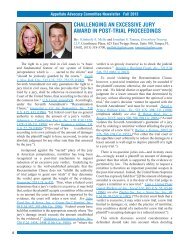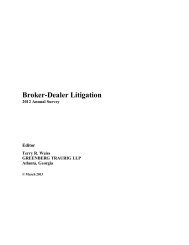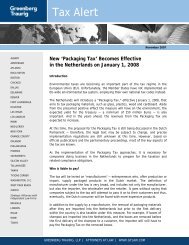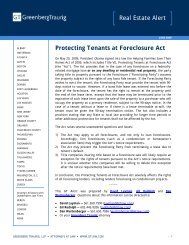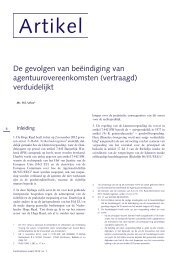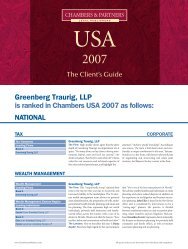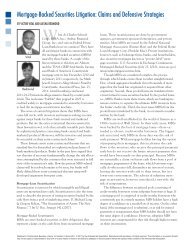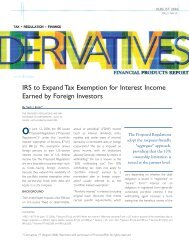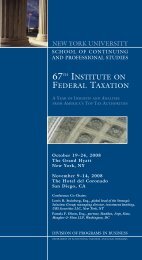Practical US/International Tax Strategies - Greenberg Traurig LLP
Practical US/International Tax Strategies - Greenberg Traurig LLP
Practical US/International Tax Strategies - Greenberg Traurig LLP
Create successful ePaper yourself
Turn your PDF publications into a flip-book with our unique Google optimized e-Paper software.
. . . as appeared in . . .<br />
<strong>Practical</strong> <strong>US</strong>/<strong>International</strong><br />
<strong>Tax</strong> <strong>Strategies</strong><br />
WorldTrade Executive, Inc.<br />
The <strong>International</strong><br />
Business Information<br />
Source TM<br />
A Twice-Monthly Report on <strong>US</strong>/<strong>International</strong> <strong>Tax</strong> Planning<br />
April 30, 2007<br />
Volume 11, Number 8<br />
New Regulations Address Application Portfolio Interest<br />
Exemption to Foreign Partners<br />
by Seth J. Entin (<strong>Greenberg</strong> <strong>Traurig</strong>, P.A.)<br />
On April 11, 2007, the IRS and Treasury issued longawaited<br />
final Regulations (TD 9323) under the “portfolio<br />
interest exemption” (Final Regulations). The Final<br />
Regulations are very favorable to foreign partners in<br />
partnerships—such as funds—that hold both equity and<br />
debt of U.S. companies. In addition, the Final Regulations<br />
are of significant interest to holders of interests in Canadian<br />
income trusts that fund their investments in U.S. target<br />
corporations with a combination of debt and equity. 1<br />
Background<br />
By way of background, two different U.S. federal<br />
income tax regimes apply to nonresident aliens and foreign<br />
corporations. First, a nonresident alien or foreign corporation<br />
that is engaged in a trade or business in the United States<br />
is taxed on income that is “effectively connected” with that<br />
trade or business. Effectively connected income is taxed<br />
on a net basis (i.e., deductions allocable to that income are<br />
allowed) 2 at the applicable graduated U.S. individual or<br />
corporate rates. 3<br />
A different regime applies to income that is not<br />
effectively connected with a U.S. trade or business. Under<br />
this regime, a flat 30 percent tax is imposed on U.S. source<br />
“fixed or determinable, annual or periodical income”<br />
(such as interest, dividends, rents, royalties and similar<br />
types of income) earned by a nonresident alien or foreign<br />
corporation. 4 This tax is imposed on gross income, with<br />
no deductions allowed. In general, this tax is collected by<br />
means of withholding, 5 and is commonly referred to as the<br />
“30 percent withholding tax.” The 30 percent withholding<br />
tax may be reduced or eliminated by bilateral income tax<br />
treaties to which the United States is a party.<br />
Furthermore, it is possible, even without the benefit of<br />
a treaty, to avoid the 30 percent withholding tax on interest<br />
Seth J. Entin (entins@gtlaw.com) is a Shareholder at the Miami<br />
office of <strong>Greenberg</strong> <strong>Traurig</strong>, P.A. He specializes in designing<br />
tax-efficient structures for foreign operations by U.S.-based<br />
multinational companies, as well as cross-border M&A,<br />
restructurings and asset transfers.<br />
income. Since 1984, the 30 percent withholding tax does not<br />
apply to “portfolio interest” earned by a nonresident alien or<br />
foreign corporation. 6 This exemption from tax is commonly<br />
referred to as the “portfolio interest exemption.”<br />
Portfolio interest is interest (including original issue<br />
discount) that meets certain specific requirements. These<br />
requirements vary depending on whether the debt<br />
obligation is issued in “registered” or “bearer” form. 7<br />
Generally, interest on an obligation in registered form<br />
constitutes portfolio interest if the withholding agent<br />
receives a Form W-8 stating that the beneficial owner of<br />
the obligation is not a U.S. person. 8 Interest earned on<br />
an obligation that is not in registered form (i.e., in bearer<br />
form) can constitute portfolio interest if the issuer of the<br />
obligation complies with certain procedures generally<br />
designed to ensure that the holder of the obligation is not<br />
a U.S. person. 9<br />
There are, however, certain limitations on the<br />
availability of the portfolio interest exemption. For example,<br />
the portfolio interest exemption does not apply to:<br />
• interest received by a “10 percent shareholder” of the<br />
borrower; 10<br />
• interest received by a controlled foreign corporation<br />
from a related person; 11<br />
• interest received by a bank on an extension of credit<br />
made pursuant to a loan agreement entered into in the<br />
ordinary course of its trade or business; 12<br />
• certain contingent interest. 13<br />
The 10 Percent Limitation<br />
The portfolio interest exemption does not apply<br />
to interest received by a “10 percent shareholder” of<br />
the borrower. In the case of an obligation issued by a<br />
corporation, a “10 percent shareholder” is any person<br />
who owns 10 percent or more of the total combined voting<br />
power of all classes of stock entitled to vote. 14 In the case<br />
of an obligation issued by a partnership, a “10 percent<br />
shareholder” is any person that owns 10 percent or more<br />
of the capital or profits interest in the partnership. 15 The §<br />
318 attribution rules apply in determining ownership for
u.s.<br />
purposes of the 10 percent limitation, with several important<br />
modifications. 16 One example, discussed later in this article,<br />
is that under the § 318 attribution rules, a person who<br />
owns an option to acquire stock is treated as owning such<br />
stock. 17 The portfolio interest statute, however, modifies that<br />
general rule. This modification provides that ownership of<br />
an option to acquire stock is not treated as stock ownership<br />
in applying the attribution rules to determine whether stock<br />
ownership is attributed from a partnership to its partner,<br />
from a trust to its beneficiaries or from a corporation to its<br />
shareholders (or vice versa). 18<br />
Whether the 10 Percent Limitation is Tested at the<br />
Partnership or Partner Level<br />
Practitioners and commentators have long grappled<br />
with the question of how the 10 percent limitation is tested<br />
if the holder of the debt is a partnership that has foreign<br />
partners. The issue is whether the 10 percent limitation<br />
is tested at the partnership level (an “entity” approach)<br />
or at the partner level (an “aggregate” approach). Under<br />
the entity approach, the determinative factor is whether<br />
the partnership itself owns a 10 percent or greater interest<br />
in the U.S. borrower. If it does, the interest paid by the<br />
U.S. borrower will not qualify for the portfolio interest<br />
exemption, regardless of the magnitude of the foreign<br />
partner’s interest in the partnership. On the other hand,<br />
if the 10 percent limitation is tested at the partner level,<br />
one would look to the proportionate indirect ownership<br />
interest of each foreign partner in the borrower to determine<br />
whether the foreign partner qualifies for the portfolio<br />
interest exemption on the partner’s proportionate share of<br />
the interest income. 19<br />
To illustrate this issue, assume that a partnership<br />
(U.S. or foreign) holds a debt instrument issued by a U.S.<br />
corporate borrower. The partnership also owns 20 percent<br />
of the voting stock of the borrower. One hundred unrelated<br />
nonresident alien partners each owns 1 percent of the<br />
partnership. If the 10 percent limitation is tested at the<br />
partnership level, the interest paid by the U.S. borrower<br />
will not qualify for the portfolio interest exemption, because<br />
the partnership owns 20 percent of the corporation’s voting<br />
stock. However, if the 10 percent limitation is tested at<br />
the partner level, the interest income will qualify for the<br />
portfolio interest exemption, because none of the partners<br />
indirectly owns a 10 percent or greater interest in the U.S.<br />
borrower.<br />
For some time, the only indication of the IRS’ position<br />
was a 1994 Field Service Advice that took the position that<br />
the 10 percent limitation is tested at the partner level, not<br />
at the partnership level. 20 A Field Service Advice, however,<br />
is not binding authority. Therefore, practitioners have<br />
clamored for more formal IRS guidance. 21<br />
The IRS and the Treasury Department issued proposed<br />
regulations (REG-118775-06) addressing this issue (Proposed<br />
Regulations) on June 13, 2006. The Proposed Regulations, as<br />
well as the Final Regulations, adopt the taxpayer-friendly<br />
“aggregate” approach. Under this approach, when interest<br />
is paid to a partnership, the persons who are deemed<br />
to “receive” the interest for purposes of applying the 10<br />
percent limitation are the nonresident alien individual<br />
partners and the foreign corporations that are partners in<br />
the partnership. The 10 percent limitation is then applied<br />
by determining each such person’s ownership interest in<br />
the obligor. Therefore, in the above illustration, the interest<br />
would qualify for the portfolio interest exemption. 22<br />
Accordingly, under the Final Regulations, foreign<br />
partners in a partnership can earn their distributive share<br />
of the partnership’s interest income free of the 30 percent<br />
withholding tax even if the partnership holds 10 percent<br />
or more of the equity in the U.S. borrower, as long as the<br />
partners do not each own a 10 percent or greater direct or<br />
constructive equity interest in the U.S. borrower.<br />
The Preamble to the Proposed Regulations states that<br />
Treasury’s adoption of the aggregate approach reflects<br />
its view that a partnership may be treated either as an<br />
aggregate of its partners or as an entity separate from its<br />
partners, depending on which characterization is more<br />
appropriate to carry out the purpose of the specific Code<br />
provision at issue. According to the Preamble, the aggregate<br />
approach in the case at hand is supported by the policy and<br />
structure of the portfolio interest statute. 23<br />
Application of the 10 percent Limitation to Trusts<br />
The Final Regulations also provide rules applying the<br />
10 percent limitation to interest paid to a “simple trust”<br />
or “grantor trust” of which a nonresident alien or foreign<br />
corporation is a beneficiary.<br />
Although a trust generally computes its taxable<br />
income in the same manner as an individual, 24 the Code<br />
contains rules that generally permit a trust that is required<br />
to distribute all of its income currently (a “simple trust”)<br />
to deduct the amounts it is required to distribute to<br />
beneficiaries. 25 To the extent that a simple trust claims a<br />
deduction for amounts it is required to distribute to its<br />
beneficiaries, the trust generally functions as a “passthrough”<br />
entity because such amounts are generally subject<br />
to taxation in the hands of the beneficiaries, retaining the<br />
same character and source as the amounts received by the<br />
trust. 26<br />
In addition, under the “grantor trust” rules, which<br />
generally apply to situations where a grantor or other<br />
person has certain retained rights or powers with respect to<br />
trust property or trust income, the grantor or other person<br />
may be considered the owner of all or a portion of the trust.<br />
To that extent, the grantor or such other person (and not the<br />
trust) is required to take into account the items of income,<br />
deduction, and credit of the trust.<br />
When interest is paid to a simple trust or a grantor<br />
trust, an issue arises as to whether the 10 percent limitation<br />
should be applied at the trust level or the beneficiary or<br />
owner level. Under the Final Regulations, when interest<br />
is paid to a simple trust or grantor trust and the interest<br />
© WorldTrade Executive, Inc. 2007 April 30, 2007
u.s.<br />
is distributed to or included in the gross income of a<br />
nonresident alien individual or foreign corporation that is<br />
a beneficiary or owner of the trust, as the case may be, the<br />
10 percent limitation is applied at the beneficiary or owner<br />
level.<br />
Time When 10 Percent Limitation is Tested<br />
The statute does not explicitly provide the time when<br />
the 10 percent limitation is tested. The Final Regulations<br />
provide that the 10 percent limitation is tested with respect<br />
to a nonresident alien individual or foreign corporation that<br />
is a partner in the partnership at the time that a withholding<br />
agent, absent any exceptions, would otherwise be required<br />
to withhold under Sections 1441 and 1442 with respect<br />
to such interest. 27 For example, in the case of U.S. source<br />
interest paid by a domestic corporation to a domestic<br />
partnership or “withholding foreign partnership,” the 10<br />
percent limitation is applied when any distributions that<br />
include the interest are made to a foreign partner and, to<br />
the extent that a foreign partner’s distributive share of the<br />
interest has not actually been distributed, on the earlier of<br />
the date that the statement required under Section 6031(c) 28<br />
is mailed or otherwise provided to such partner, or the due<br />
date for furnishing such statement. 29<br />
Effective Date<br />
The Proposed Regulations were proposed to apply<br />
to interest paid on obligations issued on or after the date<br />
that the Regulations are issued as final Regulations. What<br />
was curious about this position is that if Treasury truly<br />
believed that the aggregate approach reflected the proper<br />
interpretation of the statute, this interpretation should<br />
presumably control regardless of when the obligation was<br />
issued. Fortunately, the Final Regulations, while providing<br />
that the provisions relating to the 10 percent limitation are<br />
to apply to interest paid after the date the Regulations are<br />
published as final Regulations, also permit taxpayers to<br />
choose to apply the provisions to interest paid in any taxable<br />
year that is not closed by the period of limitations, provided<br />
that the taxpayer consistently applies the provisions to all<br />
relevant partnerships during such years.<br />
Planning Opportunities<br />
The Final Regulations present at least two important<br />
opportunities for foreign persons investing in the United<br />
States. First, the Final Regulations establish the general<br />
proposition that the 10 percent limitation is tested at the<br />
partner level. Therefore, if a partnership invests in the debt<br />
of a U.S. borrower, a foreign partner’s distributive share<br />
of the interest income can qualify for the portfolio interest<br />
exemption even if the partnership owns a 10 percent or<br />
greater interest in the U.S. borrower, so long as the foreign<br />
partner’s interest in the U.S. borrower is less than 10 percent.<br />
This significantly expands the opportunities for foreign<br />
investment in partnerships that hold U.S. debt instruments,<br />
such as funds.<br />
Furthermore, it would appear that the Final Regulations<br />
may provide an opportunity for foreign investors, through<br />
a properly structured partnership investment vehicle,<br />
to obtain ownership potential in a U.S. corporate or<br />
partnership borrower through an option or convertible<br />
debt without forfeiting the portfolio interest exemption.<br />
This is because, under the Final Regulations, the 10 percent<br />
limitation is tested at the partner level. Yet at the same time,<br />
as discussed above, an option (which generally includes a<br />
conversion right) is not attributed from a partnership to its<br />
partners under the statutory portfolio interest attribution<br />
rules. Therefore, when testing the 10 percent limitation at<br />
the partner level, a conversion right or option held by the<br />
partnership should not be attributed to the partners due to<br />
the statutory restriction on attribution.<br />
For example, assume that two unrelated foreign<br />
persons, X and Y, wish to loan money to a U.S. corporation<br />
and to obtain upside equity potential and control potential<br />
in the U.S. borrower through convertible debt instruments.<br />
If X and Y were each to directly acquire a debt instrument<br />
convertible into a 10 percent or greater equity interest in the<br />
borrower, neither of them would be entitled to the portfolio<br />
interest exemption, and thus they would both be subject to<br />
the 30 percent withholding tax on the interest (subject to<br />
reduction by treaty).<br />
On the other hand, suppose that X and Y formed a<br />
partnership that acquired a debt instrument convertible<br />
into a 10 percent or greater voting equity interest in the<br />
U.S. borrower. Under the Final Regulations, X and Y<br />
could obtain equity potential and control potential in the<br />
U.S. borrower without forfeiting the portfolio interest<br />
exemption. Although the partnership would be deemed<br />
to own a 10 percent or greater voting equity interest in the<br />
borrower by virtue of the conversion feature, that deemed<br />
ownership would not be attributed to X and Y due to<br />
the attribution limitation of § 871(h)(3)(C)(iii). While this<br />
conclusion is surprising, this is indeed the result reached<br />
by the IRS in the 1994 FSA. 30<br />
As a result, X and Y could earn interest on the<br />
convertible debt instrument free of U.S. federal income tax.<br />
Moreover, if the value of the U.S. borrower increases, and<br />
X and Y wish to exercise their conversion rights 31 and then<br />
sell their stock in the borrower, X and Y could do so free of<br />
U.S. federal income tax. 32 Conclusion<br />
These Final Regulations should be of great interest<br />
to foreign investors who invest in the United States and<br />
to funds which seek to provide tax-efficient investment<br />
vehicles for foreign investors.<br />
___________<br />
1<br />
The Canadian income trust market has recently been<br />
negatively affected by changes in the Canadian law that would<br />
significantly reduce the tax advantages of such trusts.<br />
2<br />
§§ 873(a) and 882(c)(1)(A). All section references are to the<br />
Internal Revenue Code of 1986, as amended (Code) and the<br />
<strong>Practical</strong> <strong>US</strong>/<strong>International</strong> <strong>Tax</strong> <strong>Strategies</strong> © WorldTrade Executive, Inc. 2007
u.s.<br />
Treasury regulations thereunder, unless otherwise indicated.<br />
3<br />
§§ 871(b) and 882(a). In the case of a foreign corporation, such<br />
income may also be subject to the branch profits tax. § 884.<br />
4<br />
§§ 871(a) and 881.<br />
5<br />
§§ 1441 and 1442.<br />
6<br />
§§ 871(h) and 881(c).<br />
7<br />
§§ 871(h)(2) and 881(c)(2).<br />
8<br />
§§ 871(h)(2)(B) and 881(c)(2)(B).<br />
9<br />
§§ 871(h)(2)(A) and 881(c)(2)(A).<br />
10<br />
§§ 871(h)(3) and 881(c)(3)(B).<br />
11<br />
§ 881(c)(3)(C).<br />
12<br />
§ 881(c)(3)(A).<br />
13<br />
§§ 871(h)(4) and 881(c)(4).<br />
14<br />
§ 871(h)(3)(B)(i).<br />
15<br />
§ 871(h)(3)(B)(ii).<br />
16<br />
§ 871(h)(3)(C).<br />
17<br />
§ 318(a)(4).<br />
18<br />
§ 871(h)(3)(C)(iii).<br />
19<br />
See, e.g., David C. Garlock, Federal Income <strong>Tax</strong>ation of Debt<br />
Instruments (4th ed. 2000) § 17.04(C); Seth J. Entin, Partnerships<br />
and the Portfolio Interest Exemption, 100 <strong>Tax</strong> Notes 1171 (Sept.<br />
1); Andrew W. Needham, A Guide to <strong>Tax</strong> Planning for Private<br />
Equity Funds and Portfolio Investments (Part 1), <strong>Tax</strong> Notes,<br />
1215, 1239-40 (May 20, 2002); Robert J. Staffaroni, Partnerships:<br />
Aggregate v. Entity in U.S. <strong>International</strong> <strong>Tax</strong>ation, 49 TAX<br />
LAW. 55, 123 (1995).<br />
20<br />
1994 WESTLAW 1866354; 1994 FSA LEXIS 430 (Feb. 2,<br />
1994).<br />
21<br />
ABA Section of <strong>Tax</strong>ation, The Need for Guidance on the<br />
Portfolio Interest Exemption, TAX NOTES 701 (May 10,<br />
2004).<br />
22<br />
Treas. Reg. § 1.871-14(g)(3)(i).<br />
23<br />
The Preamble to the Proposed Regulations also states that<br />
no inference is intended as to whether the other limitations<br />
set forth in the definition of portfolio interest should be<br />
considered at the partner level, partnership level, or at both<br />
levels. Hopefully, such guidance will be forthcoming from the<br />
IRS and Treasury in the not-too-distant future.<br />
24<br />
§ 641(b).<br />
25<br />
§ 651.<br />
26<br />
§ 652(b); Rev. Rul. 55-414, 1955-1 CB 385.<br />
27<br />
Treas. Reg. § 1.871-14(g)(3)(ii).<br />
28<br />
Section 6031(c) generally requires that nominees holding<br />
partnership interests for other persons provide the partnership<br />
with the name and address of the beneficial owner and any<br />
other information prescribed by the Secretary, and provide the<br />
beneficial owner with the information provided to the nominee<br />
by the partnership.<br />
29<br />
Treas. Reg. § 1.871-14(g)(ii).<br />
30<br />
Under current law, the IRS may be able to avoid the<br />
inconsistency resulting from the interplay of the aggregate<br />
approach and the option attribution rules if it were to use §<br />
1.701-2 of the Regulations (partnership anti-abuse regulations),<br />
which were promulgated after the date of the 1994 FSA, to<br />
treat an option owned by a partnership as directly owned by<br />
the partners in testing the 10 percent limitation.<br />
31<br />
See Rev. Rul. 72-265, 1972-1 C.B. 222 (no gain is realized upon<br />
the exchange of a convertible debenture for stock of the obligor<br />
corporation).<br />
32<br />
Foreign persons are not subject to U.S. federal income tax on<br />
gain from the sale of stock that is not deemed to be effectively<br />
connected with a U.S. trade or business. See §§ 881(a)(2), (4);<br />
871(a)(1)(B), (D); Treas. Reg. §§ 1.881-2(a)(1); 1441(c)(1); 1.1441-<br />
2(b)(2)(i); 1.1441-5(b)(2)(i)(B). If the stock constitutes a “U.S.<br />
real property interest,” the gain from the sale of the stock will<br />
be deemed to be effectively connected with a U.S. trade or<br />
business. § 897.<br />
© 2007 <strong>Greenberg</strong> <strong>Traurig</strong>. This <strong>Greenberg</strong> <strong>Traurig</strong> article is<br />
issued for informational purposes only and is not intended<br />
to be construed or used as general legal advice. ❏<br />
Reprinted from the April 30, 2007 issue of <strong>Practical</strong> U.S./<br />
<strong>International</strong> <strong>Tax</strong> <strong>Strategies</strong>.<br />
©2007 WorldTrade Executive, Inc.<br />
© WorldTrade Executive, Inc. 2007 April 30, 2007



